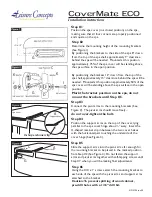
QTS-6000 Series
Analog Transmitter/Sensor
B71050-021-000-RB.doc
ELECTROCHEMICAL TRANSMITTER
JUL. 18, 2007
PRODUCT MANUAL
5
4.2 Two Wire Transmitters
The standard transmitter output signal is 4 - 20 mA DC. If the current draw required for operation of the
transmitter is less than 4 mA DC, then only two wires are needed; for power and signal (See figure 2). The
connection to ground is supplied by the monitoring equipment, which measures the voltage developed by the
current across a precision resistor. A functioning transmitter will always draw its operating current, so
there will always be some output signal in a functioning circuit.
4.3 Intrinsic Safety vs. Explosion Proof Enclosures for Hazardous Locations
Special considerations are necessary in hazardous locations areas where flammable or explosive dusts and/or
gases may be present. Such areas are generally classified as either Class 1 (gases) or Class 2 (dusts) and
Division 1 (danger is normally present) or Division 2 (danger is present under failure conditions). An
additional Group letter code specifies the gases or dusts presenting the hazard. Electrical equipment
installed in these areas must be protected from generating a spark of sufficient ignition temperature that an
explosion may occur. There are two approaches to these installations.
The first approach is to install the electrical equipment in certified explosion-proof enclosures. When
properly installed, these heavy metal enclosures are sealed from the hazardous condition and guaranteed to
contain any spark or flame that might occur in the electronics. Unfortunately, access to the contents
requires measures to ensure that the area is in a non-hazardous condition.
The second approach is an Intrinsically Safe (IS) installation (See Figure 3). In this approach, voltages and
currents into the hazardous area are limited by specially designed IS barriers. The electronic equipment is
designed so that energy storage devices (inductive or capacitive) in the electrical device cannot store
sufficient energy to cause ignition of the gases to be found in the hazardous area.
Figure 2 -Two Wire Transmitters








































